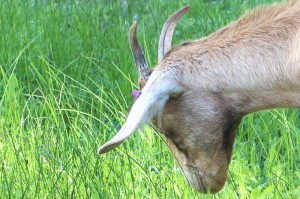Handy Horns
 In the US, most goats have their horns removed – usually within 2 weeks of being born – and the breeders are enthusiastic supporters of the process called “disbudding“. Many breeders in Australia also do this, but I am relieved that Andreas and Sonja at Koonac don’t.
In the US, most goats have their horns removed – usually within 2 weeks of being born – and the breeders are enthusiastic supporters of the process called “disbudding“. Many breeders in Australia also do this, but I am relieved that Andreas and Sonja at Koonac don’t.
Midge and Smudge have beautiful and different shaped horns but they can both reach any part of their body with them and they regularly contort themselves while having a good scratch. I was surprised how warm the horns feel which shows they are living tissue with a blood supply. Apparently they are used for temperature regulation as well as fighting.
 The stated reason not to have horned goats is to reduce injury and you can see how a goat with horns could have an advantage over one without. Having watched Midge butt Smudge around the paddock, it wouldn’t have mattered if Smudge had horns or not as Midge always butted her in the side or up her bottom. Goats only go head to head if they are challenging for position.
The stated reason not to have horned goats is to reduce injury and you can see how a goat with horns could have an advantage over one without. Having watched Midge butt Smudge around the paddock, it wouldn’t have mattered if Smudge had horns or not as Midge always butted her in the side or up her bottom. Goats only go head to head if they are challenging for position.
In 2002, Australian goat breeder associations/societies decided that for safety reasons, goats would not be allowed to participate in shows if they had horns, to protect handlers, judges, other goats and an uninformed public audience. I am not a fan of the procedure, as it is changing the physical nature of an animal just to make it easier to handle. I can understand breeding naturally polled animals to create a safer animal, but I don’t feel comfortable with what the UK Vet College calls mutilation, likening it to tail docking, ear cropping and de-clawing. I can’t imagine a Highlan’ Coo without its horns either and those horns could do a whole lot more damage.
Castration is a whole different issue and one we may have to face in September when Midge has her kids.
The WA Department of Agriculture states that: Disbudding of kids should be by heat cautery only. The operation must be performed as soon as the bud can be located. Regrowth of horn occurs very readily, so kids should be checked two to three weeks after budding. Disbudding by means of chemicals is not recommended (interestingly Victoria and the Meat and Livestock both state it is not acceptable.) Dehorning (as distinct from disbudding) should only be performed under general anaesthesia or narcosis. Dehorning should only be performed by an experienced operator or by, or under the supervision of, a veterinary surgeon.
In the UK the removal of the horn buds in goat kids can only be carried out by a veterinary surgeon. The Royal College of Veterinary Surgeons considers the act of disbudding to be a mutilation like tail docking, ear cropping and de-clawing. “It requires serious thought before being undertaken, but it is accepted that for management and welfare reasons it is often necessary in larger goat enterprises. As the horn bud grows extremely rapidly in goat kids they should be disbudded between 2-7days old, and must only be done by a vet with the kids under general anaesthesia +/- local nerve blocks. Goat kids have very thin skulls and disbudding carried out by an untrained operative can easily cause irreparable damage to the brain, either by direct heat transfer damage, or by facilitating the entry of bacteria into the skull leading to a potentially fatal meningitis.”

Facebook